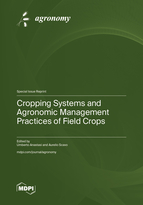A Trade-Off between the Growing Performance and Sowing Density of Sunflower (Helianthus annuus L.) under Fertigation in an Arid Saline Area
Round 1
Reviewer 1 Report
Comments for author File: ![]() Comments.pdf
Comments.pdf
Author Response
Thank you for your generous suggestions. Please see the attachment.
Author Response File: ![]() Author Response.docx
Author Response.docx
Reviewer 2 Report
Interesting study. Technically I have no real problems with your study. My main issue is reader accessibility. The published paper will be read by those with both a technical detailed interest in your work and those who are less knowledgeable in your field. I therefore have a number of suggestions for the revision of the MS which are designed to improve accessibility and clarity.
1. The introduction reads well
2. Line 92 you state that the salinity is 5 g/L and on line 94 you state that the ECe is 5.7 dSm-1. The low value of EC relative to salinity implies that your soils are rich in sulphate or carbonate is this the case? TDS is normally defined as TDS = F ECe. Your implied F is 0.877. It is not clear whether you only defined salinity using EC or whether you defined salinity separately using ISE or another approach. Please clarify.
3. Please define at the first mention of SMP that you are referring to soil potential matric, and provide the equation you used in the study to calculate SMP
4. Table 3 an enlarged explanation is required in the table caption for the notations Aa to Cc as the current footnote is inadequate the reader has to be able to easily distinguish between the different notations. This is required for clarity. Table 4 as per Table 3, but you should explain why the notations attached to the measurements in each of Table 3 and 4 for the same sample point are different. The same comment applies to Tables 5 & 6. Perhaps you could put an additional table defining A to C and a,b,c, etc.
5. Line 303 you need to provide the equation used to calculate LAI
6. Line 309 you need to provide a definition and equation for ET
7. line 271 you need to provide a definition and equation for IWP
I think that you should define ET, SMP, IWP, TSW, and LAI in the methodology section in the revised MS.
Line 141, please expand on your extract methodology as not all readers will be able to obtain access to reference 31, and a variety of extract methods are in common use. The current edition of ref 31 is 2012 not 1990 please check which version you are using and clarify in the reference list.
why did you not use a more recent methodology, e.g.
Corwin, Dennis L., S. M. Lesch, and D. B. Lobell. "Laboratory and field measurements." Agricultural salinity assessment and management (2nd Ed., pp. 265–341). Reston, VA: American Society of Civil Engineers, Environmental and Water Resources Institute (2012).
Rhoades, J. D., Fernando Chanduvi, and S. M. Lesch. Soil salinity assessment: Methods and interpretation of electrical conductivity measurements. No. 57. Food & Agriculture Org., 1999.
Visconti, Fernando, and José Miguel de Paz. "Electrical conductivity measurements in agriculture: The assessment of soil salinity." New trends and developments in metrology 1 (2016): 99-126.
This list is not exhaustive but does indicate that you need to expand, define and justify the the approach you have used.
Your style of writing uses large paragraphs which incorporate a number of points. I think that reader access particularly for those whose first language is not English would be improved if some of your paragraphs were split into several paragraphs. For example in Section 3.4, natural paragraph breaks occur at lines 271, and 275 or 277. A similar breakdown of your long paragraphs can be made elsewhere. This suggestion is optional, but is designed to improve reader access to the points you make.
Author Response
Thank you for your generous suggestions. Please see the attachment.
Author Response File: ![]() Author Response.docx
Author Response.docx
Reviewer 3 Report
The authors did lots of field works on the influence of sowing density on the growing performance, soil salinity, yield under drip fertigation conditions. Generally, the manuscript is interesting and well organized. I do believe the topic is relevant in view of the economical and nutritional importance of sunflower worldwide. The main concern that I have is why the fertilizer amounts were the same in all treatments? Since we know that there are nutrients requirement differences in responses to sowing density of any crops, the fertilizers exceeding crop demand might lead to changes in EC and pH in soil directly/indirectly, even limit the yield potential in some sowing density treatments, shouldn't the authors comment on this problem?
Author Response
Thank you for your generous suggestions. Please see the attachment.
Author Response File: ![]() Author Response.docx
Author Response.docx
Reviewer 4 Report
The methodology needs to be improved. Discussion to be improved. Too much described about other plants. Little comparison with other sunflower results. The work is poorly written. 35 comments have been marked in the text.
Comments for author File: ![]() Comments.pdf
Comments.pdf
Author Response
Thank you for your generous suggestions. Please see the attachment.
Author Response File: ![]() Author Response.docx
Author Response.docx
Round 2
Reviewer 4 Report
Almost all my comments have been taken into account and corrected. Only 2 small remarks have been marked in the text. This should be improved.
Comments for author File: ![]() Comments.pdf
Comments.pdf
Author Response
Please see the attachment.
Author Response File: ![]() Author Response.docx
Author Response.docx





